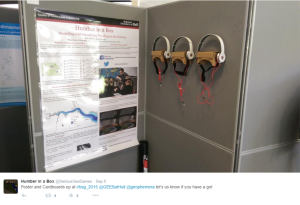By Svenja Riedesel, Aberystwyth University
I’m a second year PhD student in Geography and Earth Sciences at Aberystwyth University. I’m glad I made the decision to move from Germany to the UK to study here for my PhD.
In this post, I’d like to tell you how it is for me to live and study abroad and give a few tips about doing a PhD abroad.
How did I end up doing a PhD in the UK?
By chance I ended up taking a short course on luminescence dating at Aberystwyth University, which was followed by a four week research stay a couple of months later. I fell in love with luminescence, the charismatic little Welsh town on the Irish Sea coast and the friendly chatty Welsh people. I was fortunate to secure funding for a PhD, therefore the last step was to pack my things and move to the UK. I didn’t even really think about it, I just went. My family supported me in this decision. Some others raised concern: living of a scholarship abroad…you will not pay into a retirement or unemployment fund (very German thing), what if Brexit happens and they kick you out? However, I had confidence in my decision and hoped my choice would pay off in the long run.
Ups and downs
Now I’m a bit more than half way through my PhD and I get to enjoy it more and more. It isn’t always easy, being a day trip away from home, family and friends. However, on the bright side: I made new friends and found home in Aberystwyth (at least temporarily). This however didn’t come instantly. Firstly, everything felt more like a vacation. Then things happen, seemingly minor things such as a toilet not draining, or a wheelbarrow wheel breaking, this combined with some PhD rollercoaster moments, made me realise that I am far away from home. However, after overcoming these small hurdles I am now settled and enjoying the place I live. It took me longer than I thought, but now I can really enjoy what I’m doing, despite of being far away from home in another country.
Here are a few tips by me, things that helped me to settle in:
Organise yourself. I am an EU citizen in the UK, so many things were straight forward, but if you’d like to study outside the EU (or are a non-EU student coming to another country), you might encounter some more difficulties. You need a new bank account, health insurance, probably a new phone number, maybe a visa. Check out things well in advance and if possible, arrive a couple of days earlier to sort things out. As your first week at the University will be full of introductory courses and meeting new people, you don’t want to sort your bank account at that time.
Get out. Fortunately, I was able to bring my horse with me. He’s a bit of home away from home, my get-away-from-the-PhD and my connection to the outside of academia – something I find very important. So if you like doing sports or are passionate about music etc. try to continue with this during your PhD and get in contact with University societies, clubs or other students early on to find out what options you have.
Talk to people. Another thing I had to learn was to say yes. Just joining in, especially early on, when people ask you to join for a trip, a night out, or just a coffee break. It is always good to talk to people. Communicate with other PhD students, they are in the same position as you are, so helping each other is a great thing.
Take time for yourself. You can’t engage all the time. Personally, I got really tired at the end of the day during the first months, just from speaking a different language and listening to it all day. Now I start my day listening to my favourite German radio station on the internet while having breakfast. Every time when I go home, I buy a new book in German. I love reading in the evenings and sometimes it’s nice to have something easy to read, where the brain does not have to work that much, because of the foreign language.
Don’t be afraid of making mistakes when speaking or writing. I make mistakes when I speak or write, but this hadn’t had any influence on my PhD so far. Nobody will blame you, when you make mistakes. There was some friendly laughter by friends of mine about some ridiculous things I said, because I messed words up, but that does not impact any relationships. The only thing to keep in mind is that most universities expect a certain level of language skills, which you have to prove via a test (e.g. ILTES, but check the required test for your chosen program). I did my ILTES test well in advance to the application deadline, so in case I didn’t fulfil the requirements, I could take the test again and improve. But there is plenty help with these types of tests online, and your chosen university will be able to provide help and advice too.
Know where to get help. Your wellbeing and both your mental and physical health is important. You are not alone when doing a PhD program. First of all your supervisors are not only there to help you with scientific questions, they can give you advice and guidance too. You can talk to fellow PhD students or other international students as well. Aberystwyth University, for example, offers help, information or enables connection with other international students via social programs. Universities also offer wellbeing services you can contact.
I hope this blog posts answered some open questions, or got you interested in studying abroad for a PhD. I really think it is a great opportunity and I’m very glad I made the decision to come to the UK for my PhD.
Where to find a PhD position?
If you are interested in going abroad for a PhD, the internet is the first place to search for institutions that do research in your field of interest. If you’re able to participate at a conference during your Master’s then this is a good place to look out for researchers you might be able to work with. Another option are scientific publications. You could get in touch with the authors and ask, if they have any opportunities. Or you might be able to speak to staff in your current university who know of projects. PhD projects are also advertised on the internet (for example: https://www.earthworks-jobs.com for geoscience, https://www.findaphd.com), Twitter is also a great place to look if you follow relevant academics in your field.























